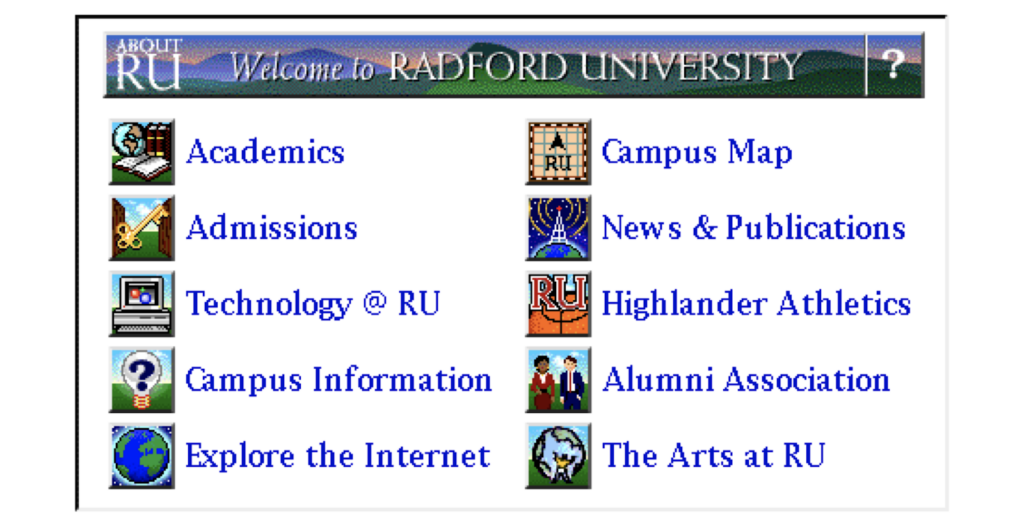I was asked to speak recently to a group of public relations professionals on the impact of technology on university publications. As a graphic designer my immediate thought was obvious. Technology has altered radically the nature of our business. Graphic designers have assumed the responsibilities of editors, typesetters, scanner operators, and a myriad of other previously specialized roles in the production process. Computers have set us free to build pages without the budget constraints that existed when every halftone, screen, and reversed headline cost extra. Not all of the changes have been good; the tools available at our mouse-clicking fingertips have served to limit our creative efforts to cliches at times. But this immediate thought was soon followed by a realization that I was answering the wrong question. I was looking at the process, instead of asking how technology has affected the product itself.
Today Radford University produces a campus newspaper, admissions and promotional materials, a quarterly alumni magazine, course catalogs, and an enormous number of informational brochures for various departments and programs. All of these things we were doing long before the first Macintosh arrived. Certainly design styles have changed, and there has been a shift in the balance of text to graphic elements in favor of the latter. But until recently there has been little substantive change in the nature of publications. Until the World Wide Web.
Taking a step back to examine the reason for this phenomenon, we see that computer technology has played two primary roles in the publishing arena. The first to develop was its role as a tool in the creation of print media. In this respect computers replaced the function of tools from previous eras to create a similar product. The second, and potentially farther reaching, has been its role as a medium for publications through networks of computers. While as a tool for print media the computer has reached a level of maturity, as a medium it is still in infancy. Initial efforts have involved a simple translation of printed material to the screen using various document viewers. The concept of nonlinear hypertext found its way quickly into computer-based publications, and has exploded since the development of the World Wide Web in 1991. But as these new uses for the medium have evolved, a subtle change has taken place. Where once editors, writers, designers and printers worked to meet a deadline, finish a publication, and release it to the world to slowly age and die, we now find ourselves writing, designing, and editing work that is never finished. It is dynamic. It is changing. It is interrelated. It is alive.
What does this change mean to those who must manage this living information? Suddenly we are faced with the realization that the sophisticated tools at our disposal are all designed to create publications which will at some point be finished. And if we apply the same principles and processes to such a medium as the World Wide Web, we will only create online versions of static information. This is evident in a great number of web sites, where information is obviously out of date or not regularly maintained. The response of the user is often simply to not return. Constant attention and effort is required to sustain a living web, and while the tools necessary to run a web site may be easy to use (as in the case of MacHTTP), there is an amazing lack of useful tools to manage living publications. As straightforward as HTML creation may be, it is not easy, nor is it fast. New tools must go beyond easier HTML creation however. They must empower the information manager to set in motion publications which change with the times, react to the reader, and grow in span and depth.
Another major change we are experiencing as a result of this emerging medium is a publishing power shift. Almost every publication about our institution once passed through the Office of Public Information. It has been the responsibility of that office to maintain high standards of writing and design, and to promote a strong graphic identity. The Web is gradually making it possible for any faculty member or student to tell their message to the world, regardless of their background as a writer, editor, or designer. Many institutions have been slow to recognize this fact, and now find themselves struggling to impose some degree of control on a chaotic interconnection of Web sites within their walls. Others are so concerned about avoiding this chaos that they choke off development altogether. One representative of a California university (which shall remain anonymous) informed me that every single page had to be approved by a WWW committee before going online. The result of course was no growth. If the approaches of either ignoring or fighting this power shift seem futile, the only remaining option is to explore ways of channeling this newfound power of the people.
In order to channel the growth of distributed publishing, it is important to examine the strengths and weaknesses of such a publishing model. An obvious strength is found in the intimate relationship between the publication and its subject. When a departmental home page is created by members of the department itself, the likelihood that the user will experience a warm, personable, and informative interchange increases greatly. A prospective student can put faces to faculty names, see pictures of students working on a recent project abroad, or explore career options for a particular field. Another benefit would be a sense of ownership for all those who participate, and with it an increased understanding of the importance of effective publications for the growth of the organization. At the same time a potential weakness lies in the fact that a fractured and disorienting network of publications can do as much to detract from the image of an institution as it can to help. The increasingly sophisticated information consumer will judge us harshly if our photographs look like mugshots and our department’s pages look as though they came from different planets. The challenge, then, is to develop an information landscape – an environment in which everything is predictable if not immediately visible, and in which there is always a clear sense of place. Key to the creation of such a landscape is a consistent visual identity and a straightforward structure. The various parts of an organization must understand their relationship to this whole. Our success in channeling the growth of a distributed Web will be directly related to our ability to provide a framework which establishes a unified, navigable environment while allowing creative freedom to each publisher.
Radford University has taken steps to build and promote such a framework, although we are not far enough along in the process to make judgements about their effectiveness. We have agreed on the importance of a carefully designed and organized web structure. Realizing that an institution’s Internet identity shouldn’t necessarily be left up to traditional technophiles to determine, we have tapped the strengths of media professionals as well as faculty, staff, and administrators in our development process. The next step has been to combine style standards and templates with regular training in HTML creation for interested faculty and staff. We also believe in the importance of some minimum level of representation for all departments on campus. The university as a whole would be poorly represented if only those departments more accustomed to technology have a voice in the new medium. To that end we will be working with representatives from every department and college to establish a web presence over the next six months. The mechanics of HTML creation aside, however, the most challenging aspect will be teaching each departmental representative to think as much like a public relations and recruiting professional as an academic.

The one question I am constantly asked as I preach the Web on campus is “Is this a fad?” To that I answer, “Yes, just like the telephone was a fad.” In ten years we will look back on these days of infancy and laugh at most of the predictions we have made. And we will wonder how we ever got along without the tools that will emerge. But there is one prediction I hope we can count on. Computers and networks will change not only the tools and the medium, but they will change us. They will tear down the walls between information providers (them) and information consumers (us). We will expect more from the world and give more to it.
And every once in a while I’ll turn it all off and sit down with a good book.

